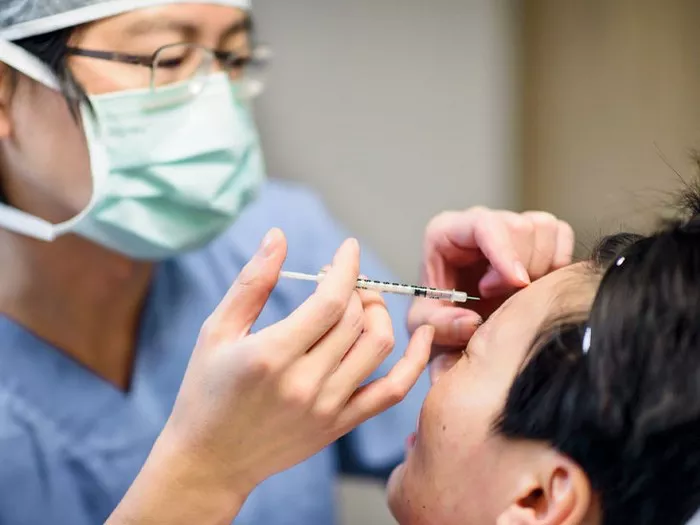Wrinkles are a natural part of the aging process, but many individuals seek ways to reduce their appearance and achieve smoother, more youthful-looking skin. Injectable treatments have become increasingly popular for wrinkle reduction, offering quick and effective solutions without the need for invasive surgery. In this article, we will explore some of the best injections for wrinkles and their benefits.
1. Botox (Botulinum Toxin Type A)
Botox is perhaps the most well-known injectable treatment for wrinkles. It contains botulinum toxin type A, which temporarily paralyzes the muscles responsible for causing dynamic wrinkles, such as crow’s feet, frown lines, and forehead lines. By relaxing these muscles, Botox smoothens the overlying skin and reduces the appearance of wrinkles.
The procedure involves a few small injections administered by a qualified healthcare professional. The effects of Botox usually last around three to four months before a touch-up treatment is required. Botox is considered safe when administered by a trained professional and has a high satisfaction rate among patients.
2. Dermal Fillers
Dermal fillers are another popular option for reducing wrinkles and restoring volume to the face. These injectable gels, typically made from hyaluronic acid (HA), a naturally occurring substance in the body, add volume to areas that have lost elasticity and firmness due to aging. They can fill in wrinkles and fine lines, plump up the lips, and enhance facial contours.
Different types of dermal fillers are available, each designed to address specific concerns. For example:
- Hyaluronic Acid Fillers: These fillers, such as Juvederm and Restylane, are versatile and commonly used for smoothing wrinkles and adding volume to various areas of the face.
- Calcium Hydroxylapatite Fillers: Fillers like Radiesse stimulate collagen production while providing immediate volume, making them suitable for deep wrinkles and facial folds.
- Poly-L-lactic Acid Fillers: Known as Sculptra, these fillers work by stimulating collagen production gradually. They are particularly useful for treating larger areas of volume loss and deeper wrinkles.
The effects of dermal fillers can last anywhere from several months to over a year, depending on the specific product used and individual factors. Regular touch-up treatments are necessary to maintain the desired results.
3. Dysport
Dysport is another botulinum toxin type A injection similar to Botox. It works by relaxing facial muscles and reducing the appearance of wrinkles. Dysport has a slightly faster onset of action than Botox, with results often visible within a few days. Like Botox, the effects typically last three to four months before additional treatments are needed.
4. Xeomin
Xeomin is another botulinum toxin type A injectable that is used to temporarily improve the appearance of moderate to severe frown lines between the eyebrows (glabellar lines). It works similarly to Botox and Dysport by relaxing the underlying muscles and reducing wrinkles. The effects of Xeomin usually become noticeable within a week and can last up to three months.
5. Platelet-Rich Plasma (PRP)
Platelet-Rich Plasma (PRP) is a regenerative treatment that utilizes the patient’s own blood to stimulate collagen production and improve skin texture. Blood is drawn from the patient, and the plasma, which contains a high concentration of platelets and growth factors, is separated and injected into the targeted areas. PRP can help reduce fine lines, improve skin tone and texture, and enhance overall skin rejuvenation.
The number of PRP treatments needed may vary, but multiple sessions are typically recommended for optimal results. Results can last several months to a year, depending on the individual and the treatment area.
6. Neurotoxin Injections
Neurotoxin injections, such as Myobloc and Nuceiva, are alternative options for reducing wrinkles. Like Botox and Dysport, these injections work by temporarily blocking the nerve signals that cause muscle contractions, effectively smoothing out wrinkles. The effects and duration of neurotoxin injections vary depending on the specific product used and individual factors.
Consultation with a Qualified Professional
Before considering any injectable treatment for wrinkles, it is crucial to consult with a qualified healthcare professional or dermatologist. They will evaluate your skin condition, discuss your goals and expectations, and recommend the most suitable treatment options for you. They can explain the benefits, potential side effects, and expected outcomes of each injection, helping you make an informed decision.
In conclusion, a range of injectable treatments are available for reducing wrinkles and achieving a more youthful appearance. Botox, dermal fillers, Dysport, Xeomin, PRP, and neurotoxin injections are among the most commonly used options. Each treatment has its unique benefits and considerations, and consulting with a qualified professional is essential to determine the best approach for your specific needs. With proper administration and care, these injections can help you achieve smoother, more refreshed-looking skin and boost your confidence.

